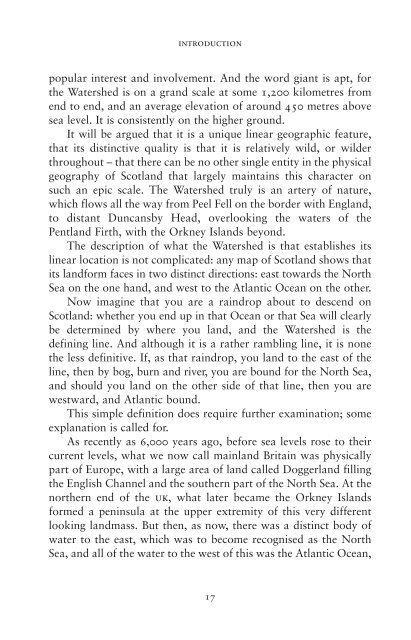Ribbon of Wilderness by Peter Wright sampler
If you’ve bagged the Munros, done the Caledonian Challenge and walked the West Highland Way, this is your next conquest. The Watershed of Scotland is a line that separates east from west; that divides those river basin areas which drain towards the North Sea from those which flow west into the Atlantic Ocean on the other. It’s a line that meanders from Peel Fell on the English border all the way to the top at Duncansby Head, near John O’ Groats – over 745 miles, through almost every kind of terrain. The Watershed follows the high ground, and offers wide vistas down major river valleys, towards towns and communities, into the heartlands of Scotland. Walk the Watershed in eight weeks Tackle short sections over a weekend 7 route maps Over 30 colour photographs Ribbon of Wildness provides a vivid introduction to this geographic and landscape feature, which has hitherto been largely unknown. The rock, bog, forest, moor and mountain are all testament to the Watershed’s richly varied natural state. The evolving kaleidoscope of changing vistas, wide panoramas, ever-present wildlife, and the vagaries of the weather, are delightfully described on this great journey of discovery.
If you’ve bagged the Munros, done the Caledonian Challenge and walked the West Highland Way, this is your next conquest.
The Watershed of Scotland is a line that separates east from west; that divides those river basin areas which drain towards the North Sea from those which flow west into the Atlantic Ocean on the other. It’s a line that meanders from Peel Fell on the English border all the way to the top at Duncansby Head, near John O’ Groats – over 745 miles, through almost every kind of terrain. The Watershed follows the high ground, and offers wide vistas down major river valleys, towards towns and communities, into the heartlands of Scotland.
Walk the Watershed in eight weeks
Tackle short sections over a weekend
7 route maps
Over 30 colour photographs
Ribbon of Wildness provides a vivid introduction to this geographic and landscape feature, which has hitherto been largely unknown. The rock, bog, forest, moor and mountain are all testament to the Watershed’s richly varied natural state. The evolving kaleidoscope of changing vistas, wide panoramas, ever-present wildlife, and the vagaries of the weather, are delightfully described on this great journey of discovery.
Create successful ePaper yourself
Turn your PDF publications into a flip-book with our unique Google optimized e-Paper software.
<strong>Ribbon</strong>s <strong>of</strong> Wildness_2016_Layout 1 24/05/2016 19:26 Page 17<br />
introduction<br />
popular interest and involvement. And the word giant is apt, for<br />
the Watershed is on a grand scale at some 1,200 kilometres from<br />
end to end, and an average elevation <strong>of</strong> around 450 metres above<br />
sea level. It is consistently on the higher ground.<br />
It will be argued that it is a unique linear geographic feature,<br />
that its distinctive quality is that it is relatively wild, or wilder<br />
throughout – that there can be no other single entity in the physical<br />
geography <strong>of</strong> Scotland that largely maintains this character on<br />
such an epic scale. The Watershed truly is an artery <strong>of</strong> nature,<br />
which flows all the way from Peel Fell on the border with England,<br />
to distant Duncans<strong>by</strong> Head, overlooking the waters <strong>of</strong> the<br />
Pentland Firth, with the Orkney Islands beyond.<br />
The description <strong>of</strong> what the Watershed is that establishes its<br />
linear location is not complicated: any map <strong>of</strong> Scotland shows that<br />
its landform faces in two distinct directions: east towards the North<br />
Sea on the one hand, and west to the Atlantic Ocean on the other.<br />
Now imagine that you are a raindrop about to descend on<br />
Scotland: whether you end up in that Ocean or that Sea will clearly<br />
be determined <strong>by</strong> where you land, and the Watershed is the<br />
defining line. And although it is a rather rambling line, it is none<br />
the less definitive. If, as that raindrop, you land to the east <strong>of</strong> the<br />
line, then <strong>by</strong> bog, burn and river, you are bound for the North Sea,<br />
and should you land on the other side <strong>of</strong> that line, then you are<br />
westward, and Atlantic bound.<br />
This simple definition does require further examination; some<br />
explanation is called for.<br />
As recently as 6,000 years ago, before sea levels rose to their<br />
current levels, what we now call mainland Britain was physically<br />
part <strong>of</strong> Europe, with a large area <strong>of</strong> land called Doggerland filling<br />
the English Channel and the southern part <strong>of</strong> the North Sea. At the<br />
northern end <strong>of</strong> the uk, what later became the Orkney Islands<br />
formed a peninsula at the upper extremity <strong>of</strong> this very different<br />
looking landmass. But then, as now, there was a distinct body <strong>of</strong><br />
water to the east, which was to become recognised as the North<br />
Sea, and all <strong>of</strong> the water to the west <strong>of</strong> this was the Atlantic Ocean,<br />
17


















